
Haarlem is a city and municipality in the Netherlands. It is the capital of the province of North Holland. Haarlem is situated at the northern edge of the Randstad, one of the more populated metropolitan areas in Europe; it is also part of the Amsterdam metropolitan area. Haarlem had a population of 162,543 in 2021.

The Frans Hals Museum is a museum in the North Holland city of Haarlem, the Netherlands, founded in 1862, known as the Art Museum of Haarlem. Its collection is based on the city's own rich collection, built up from the 16th century onwards. The museum owns hundreds of paintings, including more than a dozen by Frans Hals, to whom the museum owes its name. The Frans Hals Museum has two historic locations in Haarlem city centre: the main location on Groot Heiligland and Location Hal on Grote Markt, composed of the adjacent 17th-century Vleeshal and 19th-century Verweyhal. On Groot Heiligland is the 17th-century Oudemannenhuis with regent's rooms. It houses the famous paintings by Frans Hals and other ancient, modern and contemporary art, as well as the museum café. Location Hal regularly hosts exhibitions of modern and contemporary art.
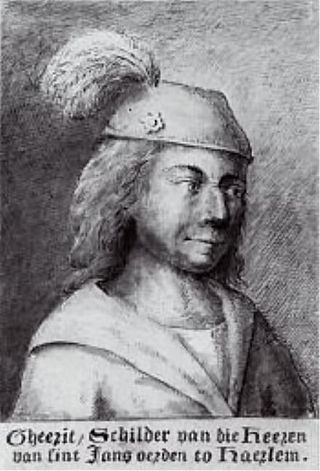
Geertgen tot Sint Jans, also known as Geertgen van Haarlem, Gerrit van Haarlem, Gerrit Gerritsz, Gheertgen, Geerrit, Gheerrit, or any other diminutive form of Gerald, was an Early Netherlandish painter from the northern Low Countries in the Holy Roman Empire. No contemporary documentation of his life has been traced, and the earliest published account of his life and work is from 1604, in Karel van Mander's Schilder-boeck.
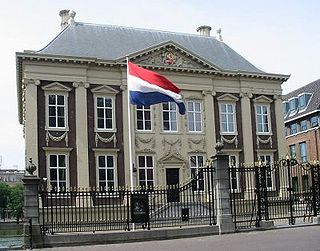
Jacob van Campen was a Dutch artist and architect of the Golden Age.
The Dutch Real Tennis Association was founded in 1986 to return the sport of real tennis to the Netherlands. The association's goals include building a real tennis court and functioning as the national governing body. Since 1987 the association has organized a Dutch Real Tennis Championship tournament at various clubs in the United Kingdom.

Salomon de Bray was a Dutch Golden Age painter and architect.

The Lords of Brederode were a noble family from Holland who played an important role during the Middle Ages and the Early modern period. The family had a high noble rank and hold the titles Count of Brederode, Count of Gennep, and furthermore they ruled the souverain Lordship of Vianen, the Viscountship of Utrecht among other feudal titles.

Museum van de Geest was created in 2020 when Het Dolhuys, the national museum for psychiatry in Haarlem, the Netherlands, merged with the Outsider Art Museum from Amsterdam. Het Dolhuys had been founded in 2005 in the newly renovated former old-age home known as Schoterburcht, located just across the Schotersingel from the Staten Bolwerk park.
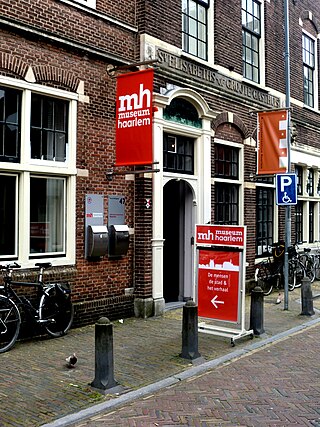
Museum Haarlem is a city museum on Groot Heiligland 47, Haarlem, Netherlands, located across the street from the Frans Hals Museum. It shares its front door with the ABC Architectuurcentrum Haarlem, which is located next door. The museum is devoted to presenting and preserving the cultural history of Haarlem and the surrounding region.

The Doopsgezinde kerk is a historical hidden Mennonite church dating from the 17th century between the Grote Houtstraat, Peuzelaarsteeg and the Frankestraat in Haarlem, Netherlands.
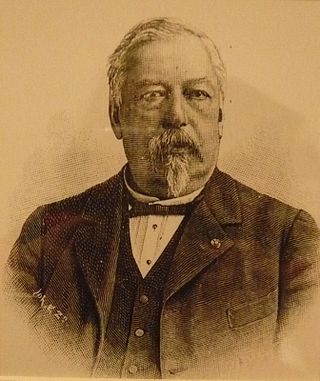
Adriaan Justus Enschedé was a Haarlem Archivist, collector, owner of the Joh. Enschedé printing company, philanthropist and a member of Teylers Tweede Genootschap.

Haerlempjes refer to a specific genre of landscape painting that includes a view of Haarlem. It is used most often to refer to Jacob van Ruisdael's panoramic views of the city, but the term is derived from mentions in Haarlem archives as a type of painting included in household inventories. The diminutive suffix "pje" would denote a small, cabinet-sized painting, but even the largest landscapes may be referred to as Haerlempjes today.

Reinoud van Brederode was a Dutch nobleman, lawyer and diplomat of the Dutch Golden Age. He was lord of Veenhuizen, Spanbroek, Oosthuizen, Etersheim, Hobrede and Kwadijk.
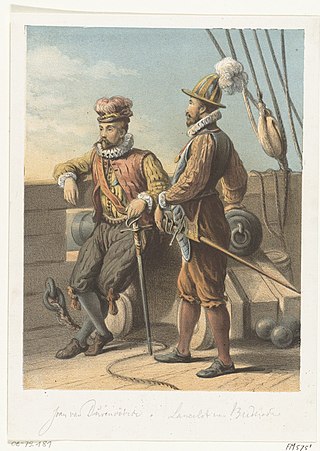
Lancelot van Brederode was a Dutch general in the Dutch Revolt. He was vice admiral of the 'geuzen' or 'Sea Beggars' and a captain in the army of Louis of Nassau.

Schoterveense Molen is a windmill in Haarlem located at Wipwatermolen Heussensstraat in the former municipality of Schoten. It is registered as a Rijksmonument.
Willem Jansz Verstraeten was a Dutch Golden Age tin-glazed maiolica maker in Haarlem.

Marquette Castle is an 18th-century manor house in Heemskerk, Netherlands, occupying the site of the previous 13th-century Heemkskerk Castle, or Huis te Heemskerk.

Batestein Castle was a princely residence in Vianen in the Dutch province of Utrecht, and South Holland. It was the main seat of the Van Brederode family. The castle was famous for its gardens and its sculptures. It has been demolished in the 19th century. Today, not much remains except a gate from the 17th century, a pump and some parts of the walls. A local foundation is working on a partial reconstruction of the gardens.



















